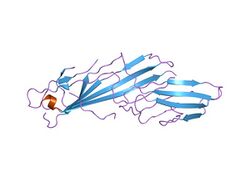Biology:Adaptor complexes medium subunit domain
| Adap_comp_sub | |||||||||
|---|---|---|---|---|---|---|---|---|---|
 mu2 adaptin subunit (ap50) of ap2 adaptor (second domain), complexed with ctla-4 internalization peptide ttgvyvkmppt | |||||||||
| Identifiers | |||||||||
| Symbol | Adap_comp_sub | ||||||||
| Pfam | PF00928 | ||||||||
| Pfam clan | CL0448 | ||||||||
| InterPro | IPR008968 | ||||||||
| PROSITE | PDOC00761 | ||||||||
| SCOP2 | 1bxx / SCOPe / SUPFAM | ||||||||
| |||||||||
In molecular biology, the adaptor complexes medium subunit domain is a protein domain found at the C-terminus of the mu subunit from various clathrin adaptor protein complexes (AP1, AP2, AP3, AP4 and AP5)[1] and muniscins. The C-terminal domain has an immunoglobulin-like beta-sandwich fold consisting of 9 strands in 2 sheets with a Greek key topology, similar to that found in cytochrome f and certain transcription factors.[2] The mu subunit regulates the coupling of clathrin lattices with particular membrane proteins by self-phosphorylation via a mechanism that is still unclear.[3] The mu subunit possesses a highly conserved N-terminal domain of around 230 amino acids, which may be the region of interaction with other AP proteins; a linker region of between 10 and 42 amino acids; and a less well-conserved C-terminal domain of around 190 amino acids, which may be the site of specific interaction with the protein being transported in the vesicle.[3]
References
- ↑ "Bivalent Motif-Ear Interactions Mediate the Association of the Accessory Protein Tepsin with the AP-4 Adaptor Complex". The Journal of Biological Chemistry 290 (52): 30736–49. 2015. doi:10.1074/jbc.M115.683409. PMID 26542808.
- ↑ "Study of the interaction of the medium chain mu 2 subunit of the clathrin-associated adapter protein complex 2 with cytotoxic T-lymphocyte antigen 4 and CD28". Biochem. J. 359 (Pt 2): 427–34. October 2001. doi:10.1042/0264-6021:3590427. PMID 11583591.
- ↑ 3.0 3.1 "The medium chains of the mammalian clathrin-associated proteins have a homolog in yeast". Eur. J. Biochem. 202 (2): 569–74. December 1991. doi:10.1111/j.1432-1033.1991.tb16409.x. PMID 1761056.
External links
- Eukaryotic Linear Motif resource motif class TRG_ENDOCYTIC_2
 |

